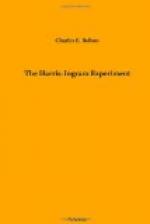The tourists found the streets in the older part of Genoa narrow, seldom more than ten feet wide, with lofty buildings on either side. But in the new portions, especially on the wide Strada Nuova and the Strada Balbi, the palaces and edifices present fine architecture.
Nearly a day was spent in driving about Genoa with its flower-crowned terraces. It was after five o’clock when the party stood before the noble statue of Columbus recently dedicated in a prominent square filled with palms and flowering shrubs, and near the principal railway station. Here the statue welcomes the coming and speeds the parting guest. Its design is admirable. Surmounting a short shaft is Columbus leaning upon an anchor, and pointing with his right hand to the figure of America; below him are discerned encircling the shaft ornaments symbolic of Columbus’s little fleet, while other statues represent science, religion, courage, and geography; between them are scenes in bass-relief of his adventurous career.
Dinner was taken aboard the yacht as it steamed away from Genoa. The flowers that Harry had bought for Lucille’s stateroom she thoughtfully placed on the table, and with the porcelain they added artistic effect. The day’s experiences were reviewed, and, as the appetizing courses were served, the conversation drifted back to the World’s Columbian Fair which all had attended. Many of the wonders of the “White City” were recounted, and Henley in his off-hand manner repeated a compliment which was paid by a cultivated Parisian who visited the Fair. The Frenchman said that at the last Paris Exposition, he saw immense and unsightly structures, such as one might expect to find in far-off Chicago, but that at the Columbian World’s Fair, he beheld buildings such as his own artistic Paris and France should have furnished; that the Columbian Fair was an artistic triumph that had never been paralleled except in the days of imperial Rome by her grand temples, palaces, arches, bridges, and statues.
“The Parisian is right, and he pays America a most deserved compliment. Never was so elegant a panorama enrolled as at Chicago,” responded Colonel Harris.
“You are correct, Colonel,” said Captain Hall, “the triumph of our Exposition was largely due to the masterly supervision which evoked uniformity of design and harmonious groupings by employing only those of our architects, sculptors, painters, and landscape gardeners, who possessed the highest skill.”
Leo ventured to add that the “White City” seemed to him dream-like and that under the magical influence of Columbus, as patron-saint, all nationality, creed, and sex, were harmoniously blended in ideal beauty and grandeur.
Lucille, who had just sipped the last of her chocolate, also bore testimony, and Harry watched her admiringly as she said, “At times, especially in the evening, when thousands of incandescent lights outlined the Court of Honor with its golden Goddess of the Republic and the facades, turrets, and domes, it seemed to some of us as if we had stepped out upon a neighboring planet, where civilization and art had been purified, or that the veil was lifted and we were gazing upon the glories of the New Jerusalem.”




